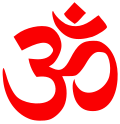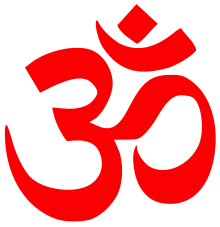ヒンドゥー教
| ヒンドゥー教 | |
|---|---|
 | |
| 国・地域 |
|
| 信者数 | 約11億人 |
| 成立年 | 紀元前13世紀頃に前身となるバラモン教が発展 |
| 創始者 | 無し(自然形成) |
| 信仰対象 | 多神教 |
| 聖典 | リグ・ヴェーダなど |
| 宗派 |
ヴィシュヌ派 シヴァ派 シャクティ派 スマルタ派など |
| 聖地 |
|
| 発祥地 | 古代インド |
| 教義 | 輪廻・解脱 |


語源と名称
編集信者
編集特徴
編集ヒンドゥー教の範囲
編集主要な神々
編集四住期
編集業と輪廻
編集カースト
編集身分(ヴァルナ)と職業(ジャーティ)
編集改宗
編集他宗教から改宗してヒンドゥー教徒になることは可能である。しかし、そこにはカースト制がある。カーストは親から受け継がれ、カーストを変えることが出来ない。カーストは職業や身分を定める。他の宗教から改宗した場合は最下位のカーストであるシュードラにしか入ることができない。生まれ変わりがその基本的な考えとして強くあり、次の生まれ変わりで上のカーストに生まれるしか方法はないと経典には記されているのが特徴である。そのため改宗による移動を行えないという点がある。
ヒンドゥー教からイスラム教や仏教へと改宗する場合は、下位のカーストの者が差別から抜け出すためであることが多い。しかし、皮肉にもイスラム教徒や、パキスタン人の間にも若干のカースト意識は有ると言われている。カーストはヒンドゥーに限らず、イスラム教徒や仏教徒なども含めた全インド文化に共通する意識であるとも言える。
河川崇拝
編集ヒンドゥー教では河川崇拝が顕著であり、水を使った沐浴の儀式が重要視されている。特にガンジス川(ガンガー)は川の水そのものがシヴァ神の身体を伝って流れ出て来た聖水とされ、川自体も女神ガンガーであるため「母なる川ガンジス」として河川崇拝の中心となっている。ガンジス川添いには沐浴場(ガート)が設けられた聖地が点在する。ヒンドゥー教徒は、沐浴場に設けられた石の階段を下りて川の水に頭までつかって罪を清め、あるいは水を飲む。
菜食主義
編集聖牛崇拝
編集ヨーガ
編集グル信仰
編集ヒンドゥー教で重要な位置を占めているのが、グル(サンスクリット語で「重いもの」「闇から光へ導くもの」「木星」「導師」という意味)である。グルはヨーガの修行を成就するにあたって、必要不可欠なものとされ、尊敬と崇拝を集めている。
女性
編集結婚
編集主な宗派
編集派生した宗教
編集ヒンドゥー教の一部と見なされることがあるもの
編集歴史
編集ヒンドゥー教はキリスト教やイスラム教のような、特定の開祖によって開かれたものではなく、インダス文明の時代からインド及びその周辺に居住する住民の信仰が受け継がれ時代に従って変化したものと考えられている。したがってヒンドゥー教がいつ始まったかについては見解が分かれている[41]。
インダス文明時代
編集ヴェーダ
編集バラモン教からヒンドゥー教へ
編集六派哲学
編集不二一元論とバクティ
編集その後のヒンドゥー教
編集教典
編集聖地
編集遺跡
編集祭礼
編集脚注
編集注釈
編集出典
編集参考文献
編集関連項目
編集外部リンク
編集- ヒンドゥ建築 (日本語)
- 『ヒンドゥー教』 - コトバンク